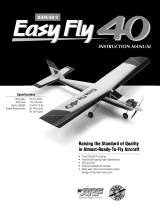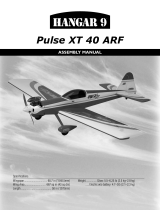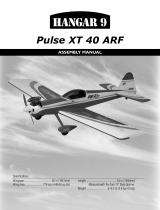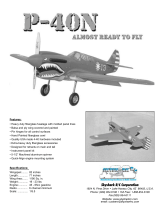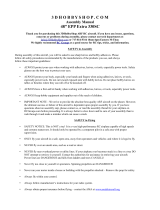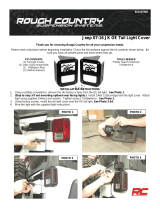Page is loading ...

INSTRUCTION MANUAL
WE GET PEOPLE FLYING
TM
TM
Specifications
Wingspan: . . . . . . . . . . . . . . . . . . . . . . . 97 in . . . . . . 2,463.8 mm
Fuselage Length: . . . . . . . . . . . . . . . . . 88 in . . . . . . 2,235.2 mm
Wing Area: . . . . . . . . . . . . . . . . . 1,750 sq in . . . . . . . . 112.9 dm2
Flight Weight: . . . . . . . . . . . 23.5 to 26.5 lb . . . 9.98–11.80 kg
Recommended Engines: . . . . . . 60 to 80 cc
• 90% custom built
• Designed by 7-time TOC
competitor Mike McConville
• Specifically designed for excellence
in precision and 3D aerobatics
• Prepainted fiberglass cowl
and wheelpants
• Plug-in wing and stab
• Precovered with genuine
Goldberg UltraCote®
• IMAC and IMAA legal
• Instructions include 3D flying tips from Mike McConville

2
Table of Contents
Introduction ..................................................................................................................................................................................... 2
Warning ..................................................................................................................................................................................... 3
Additional Equipment Required ............................................................................................................................................................ 3
Other Items Needed (not included in the kit) .........................................................................................................................................4
Tools and Supplies Needed (not included in the kit) ............................................................................................................................. 4
Contents of Kit ......................................................................................................................................................................................5
Section 1. Installing the Aileron Servos ............................................................................................................................................. 6
Section 2. Installing the Aileron Control Horns .................................................................................................................................. 7
Section 3. Hinging and Sealing the Control Surfaces ......................................................................................................................... 9
Section 4. Installing the Linkages .................................................................................................................................................... 13
Section 5. Installing the Rudder and Elevator Servos .......................................................................................................................14
Section 6. Installing the Elevator, Control Horns, and Linkages ....................................................................................................... 16
Section 7. Installing the Rudder, Control Horns, and Linkages ........................................................................................................19
Section 8. Installing the Landing Gear ............................................................................................................................................. 21
Section 9. Attaching the Tail Wheel .................................................................................................................................................. 24
Section 10. Installing the Receiver, Battery, and Fuel Tank ................................................................................................................. 25
Section 11. Mounting the Engine and Cowl ....................................................................................................................................... 27
Section 12. Hatch Assembly ..............................................................................................................................................................30
Section 13. Balancing the Model .......................................................................................................................................................31
Section 14. Radio Setup ..................................................................................................................................................................... 32
Section 15. Control Throws ...............................................................................................................................................................32
Preflight at the Field ........................................................................................................................................................................... 32
Setup and Flight Tips by Mike McConville .........................................................................................................................................33
AMA Safety Code ...............................................................................................................................................................................39
Introduction
Thank you for your purchase of Hangar 9’s Extra 330L. Because the size and weight create a higher degree for potential danger, an
added measure of care and responsibility is needed when building and flying giant-scale models. If this is your first giant-scale
aerobatic aircraft, it’s important that you carefully follow the instructions, especially those regarding hinging (pages 9–10), sealing the
hinge gaps (pages 11–12), and the section on flying (pages 33).
Like all giant-scale aerobatic aircraft, the Extra requires powerful, heavy-duty servos. Servos greatly effect the flight performance, feel,
and response of the model. To get the most out of your Extra, it’s important to use accurate, powerful servos with a minimum of 80 oz/in
of torque. In the prototype models we used JR 8101s and JR 8411s with excellent results. A less powerful servo can lead to a crash.
The Extra 330L does not include hardware. Many experienced giant-scale pilots have specific hardware preferences and can
individually choose the components that they prefer. Hangar 9 offers an optional hardware package (page 5) part (#HAN1220, JR/
#HAN1221, FUT) that includes the hardware that our staff regularly uses and recommends.
Throughout the manual, the above hardware will be used during the assembly process. If using another type/brand of hardware, it’s
your responsibility to be sure that it’s strong enough for this application and properly installed.
If you encounter difficulty in any construction sequence, please contact one of our technicians. We stand ready to provide any
assistance we can concerning the construction of your Extra 330L. Contact us at:
Horizon Hobby, Inc.
4105 Fieldstone Road, Champaign, IL 61822
(877) 504-0233 www.horizonhobby.com

Warning
An R/C aircraft is not a toy! If misused, it can cause serious bodily harm and damage to property. Fly only in open areas, preferably
AMA (Academy of Model Aeronautics) approved flying sites, following all instructions included with your radio and engine.
Additional Equipment Required
Radio Equipment with Computer Radio
• (7) Servos with 80 oz/in of torque minimum (JR8101, 4721, 2721, or 8411 or equivalent)
• 1000mAh receiver battery pack or larger
• (4) 24" Servo Extensions (JRPA102)
• (1) 18" Servo Extensions (JRPA101)
• (2) 6" Servo Extensions (JRPA095)
• (2) 12" Servo Extensions (JRPA099)
Radio Equipment Non-Computer Radio
• (7) Servos with 80 oz/in of torque minimum (JR8101, 4721, 2721, or 8411 or equivalent)
• (3) Y-Harnesses (JRP133)
• (4) 18" Servo Extensions (JRPA101)
• 1000mAh receiver battery pack or larger
• (2) 12" Servo Extensions (JRPA099)
• (2) 6" Servo Extensions (JRPA095)
Note: Requires one reversed servo for elevator
Recommended JR Systems:
• JR 400EX
• JR 421EX
• JR XP652
• JR XP783
• JR XP8103
• JR PCM10X
Engine Requirements
• 60-80 cc Gasoline Engine
Recommended Gasoline Engines:
• Zenoah G-62 Gasoline Engine
• Zenoah GT-80 Gasoline Engine
3
JR 8103
Zenoah G-62 Zenoah GT-80

4
Other Items Needed (not included in the kit)
Zenoah Gas Start-up Package (ZEN20002) Includes:
• Kill Switch (ZEN20000)
• Oil (2 Cycle) (ZEN20001
• Fuel Dot (HAN115)
• Fuel Filter (HAN143)
• Mix Cup (HAN3101)
• Gas Stopper (DUB400)
• 3' Fuel Line (DUB799)
• Line keeper (DUB677))
Tools and Adhesives Needed (not included in the kit)
Tools
• Drill
• Drill bits: 1/16", 1/8", 5/32", 1/4", 3/8", 1/2", 5/16"
• Medium Phillips screwdriver
• Small straight screwdriver
• Needle-nose pliers
• Hobby knife with #11 blade
• Mixing stick
• Straight edge
• Jig saw
• Soldering iron
• Measuring device (e.g., ruler, tape measure)
• Scissors
• Moto-tool with cut-off wheel
• 8-32 Tap (DUB363)
• Sealing iron
• Glue syringe or tooth pick
•5/32" and 1/8" Hex wrench
• Adjustable wrench
Addition Needed Items
• 4" spinner
• Propeller
(Refer to recommendations listed in your engine’s
operating instructions.)
• 2' gas compatible tubing
• Cup engine mount B+B 6202 (G-62 only)
• Coarse sandpaper
• Radio packing foam
• Antenna tube
•1/8" light plywood
• (4) 1/4"-20 x 1/4" Socket head screws (G-62 only)
• 1/3 Scale Pilot (HAN8265)
• (2) Small cable ties
• Paper towels
Adhesives
• Thick CA (cyanoacrylate) glue
• CA remover/debonder
• 30-minute epoxy
• 5-minute epoxy
• Silicon glue
• Canopy glue
• Blue Locktite®
• Electrical tape
• Masking tape
• Rubbing alcohol
• Felt-tipped pen/pencil
• White UltraCote®(GBG870)
• Pearl Blue UltraCote®(GBG845)

5
• Fuselage (HAN1201)
• Right Wing Panel with Aileron (HAN1202)
• Left Wing Panel with Aileron (HAN1203)
• Right Horizontal Stabilizer and Elevator (HAN1204)
• Left Horizontal Stabilizer and Elevator (HAN1205)
• Landing Gear Fairing (HAN1216)
• Rudder (HAN1208)
• Wing Tube (HAN1206)
• Stabilizer Tubes (2) (HAN1207)
• Canopy (HAN1209)
• Canopy Hatch (HAN1210)
• Fiberglass Painted Cowl (HAN1211)
• Wheel Pants (HAN1212)
• Landing Gear (HAN1213)
Contents of Kit
Note: Photos of products may vary slightly from the contents in the box.
•3
1/2" Wheels (2) (DUB350L)
•4
1/2" 4-40 Threaded Pro-Links (4) (HAN3556)
• 5" 4-40 Threaded Pro-Links (2) (HAN3557)
• 32 oz Fuel Tank (DUB690)
• Tail Wheel Assembly with Hardware (OHI130)
• 4-40 Ball Links (7) (ROC87)
• 8-32 Swivel Control Horns (6) (ROC01B)
• 4-40 Rod, Threaded one end (6) (DUB802)
•3/16" Main Axles (DUB249)
• Super Hinge Points (24) (ROB309)
• 4-40 1/23D Arm (11/4") JR (2) (HAN3578)
• 4-40 1/2HD Arm (1") JR (4) (HAN3574)
• 4-40 1/23D Arm (11/4") Futaba (2) (HAN3579)
• 4-40 1/2HD Arm (1") Futaba (4) (HAN3575)
• 4-40 Solder Link (2) (DUB305)
•3/16" Wheel Collars (2) (DUB141)
Included in the optional Hangar 9 1/3 Scale Hardware Package (HAN1220,JR/HAN1221, Futaba)
Replacement Parts

6
The ailerons require a minimum of 80 oz/in of servo torque. In
the prototype Extras, we used JR8101 and JR8411 servos.
JR’s 8411s offer a crisp response — the ultimate servo choice.
JR8101 Ultra Precision Wide Bearing
Torque: 90.4 oz/in Speed: .23 sec/60°
Weight: 1.5 oz Size: .73" x 1.52" x 1.32"
Motor: Coreless Ball Bearing: Dual
JR8411 Digital Ultra Torque
Torque: 155 oz/in@4.8V Speed: .18 sec/60°
Weight: 2.03 oz Size: .73" x 1.52" x 1.32"
Motor: Coreless Ball Bearing: Dual
Step 1. Install the servo hardware (grommets and eyelets)
included with the servo.
Step 2. Plug a 12" servo extension onto each servo. Tie a knot
at the connector as shown, then wrap with electrical tape to
prevent the servo connectors from pulling apart.
Step 3. Insert the servo into the aileron cutout in the bottom of
the wing as shown. Be sure the output shaft is oriented closest to
the trailing edge of the wing. Allow the servo lead to exit the root
of the wing. Refer to the photo in Step 4.
Step 4. Using the screws included with the servo, fasten the
servo in place. You may find it helpful to drill a 1/16" pilot hole
before installing the screws.
Step 5. Remove the stock arms and replace with heavy-duty
1" arms (HAN3574 JR or HAN3575) to give the needed control
throws and to handle the increased loads of the large surfaces.
The arms need to face outward toward the wing tips as shown in
the photo. Be sure to use a drop of Blue Locktite to secure the
servo arm screws if using metal-geared servos.
Section 1: Installing the Aileron Servos
• Wings w/ailerons attached (taped in place)
Not Included
• (2) servos w/mounting hardware
(80 oz/in minimum torque)
• (2) 12" servo extensions
Included in Optional Hangar 9 Hardware Package
(HAN1220 JR or HAN1221 Futaba)
• (2) 1" Servo Arms (HAN3574 JR or HAN3575 Futaba)
• Phillips screwdriver
• Drill with 1/16" drill bit
• Electrical tape
• Blue Locktite®
Parts Needed Tools and Adhesives Needed
Wing Tip
Trailing Edge

7
Step 1. Using a straight edge held in alignment (90°) with the
servo arm and with the hinge line as shown, mark the aileron with
a pen where the straight edge intersects the aileron hinge bevel.
Step 2. Measure exactly 1/4" rearward from the mark above
parallel to the hinge line and make another mark using a pen.
This will be the position for the control horn.
Step 3. Untape the ailerons from the wing. Use rubbing alcohol
to remove any tape residue. Notice that the hinge pockets are
already cut into place.
Step 4. Using a 5/32" drill bit and hand drill, carefully drill a
5/32" hole through the aileron at the marked position. [Drill
perpendicular (90°) to the aileron cross section rather than the
ailerons surface.] Be especially careful when penetrating through
the bottom surface of the aileron as it’s easy to split out the wood
and rip the covering. Placing a wooden block under the aileron
and drilling slowly will prevent these problems. If you choose to
use the counter sink screws included in the Hangar 9 Hardware
Package, counter sink the top of the aileron to allow the screws
to fit flush.
Note: A hardwood block (hardpoint) is located below the
sheeting; you will be drilling through this.
Section 2: Installing the Aileron Control Horns
• Wings with ailerons and servos
Included in Optional Hangar 9 Hardware Package
• (2) Control Horns (Rocket City 8-32 Swivel Control
Horn #ROC01B)
• 12" or longer ruler
• Drill w/ 5/32" drill bit
• 8-32 Tap (DUB363)
• 30-minute epoxy
• Pen
• Rubbing alcohol
• Paper towels
Parts Needed Tools and Adhesives Needed
90°
Hinge Pockets

8
Step 5. Using an 8-32 tap, tap the hole that you just drilled in
the aileron.
Step 6. Mix a small amount of 30-minute epoxy and lightly coat
the inside of the tapped hole and the 8-32 x 2" Rocket City screw.
From the top of the aileron, screw the 8-32 x 2" into the tapped
hole and securely tighten. Wipe away any excess epoxy with
rubbing alcohol and a paper towel. Screw the A-nut in place as
shown. Allow the epoxy to fully cure.
Step 7. Screw the molded swivel link onto the 8-32 screw until
the distance from the aileron surface to the bottom of the link
is 5/8".
Step 8. Install the control horn in the opposite aileron using the
same method.
Section 2: Installing the Aileron Control Horns
CONTINUED

9
Properly hinging the control surfaces on giant-scale models is
vitally important! Poorly installed hinges affect the model’s
precision and control response and can also be dangerous. Each
and every hinge needs to be securely bonded in place in both the
flying surface and the control surface. The hinge pivot points
need to be exactly parallel to each other and precisely located on
the center of the hinge line. We regularly use Robart Super Hinge
Points in all giant-scale aircraft. They are easy to install, very
strong, and offer smooth friction-free control. The Hangar 9
Extra 330L control surfaces are predrilled to use Robart’s Super
Hinge Points.
Step 1. Sand each end of the hinge point hinge using coarse
sandpaper. This will improve the bond of the epoxy to the hinge.
Step 2. Mix 1 ounce of 30-minute epoxy. Using a glue syringe
or toothpick, place a sufficient amount of 30-minute epoxy into
one of the hinge pockets on the wings trailing edge. Install one
of the hinge points until the hinge pin center is flush with the
trailing edge of the wing. Some epoxy should ooze out of the
pocket as the hinge is installed. If not, remove the hinge and
apply more epoxy. After gluing a few hinges, you’ll get the hang
of just how much epoxy is needed. Wipe away any excess epoxy
with rubbing alcohol. Recheck that the center of the hinge pin is
flush and parallel with the trailing edge. Continue installing
hinges in the trailing edge of the wing. The control surfaces
(ailerons) will be installed after the epoxy is fully cured.
Note: Be sure that the hinge pivot pins are parallel and
flush to the trailing edge. It’s important to frequently
mix a fresh batch of 30-minute epoxy in order to
achieve good glue joint penetration. If you notice the
epoxy becoming thicker, then mix a new batch!
Section 3: Hinging and Sealing the Control Surfaces
•Wings with ailerons
Included in optional Hangar 9 Hardware Package
•(24) Robart Super Hinge Points #ROB309
Not included
•White UltraCote®(GBG870)
•Pearl Blue UltraCote®(GBG845)
•Sealing iron
•Sharp #11 hobby knife
•Ruler, 36"
•Glue Syringe (DLR910) (or toothpick)
•Coarse sandpaper
•Pen
•30-minute epoxy
•Rubbing alcohol
•Paper towels
Parts Needed Tools and Adhesives Needed

10
Step 3. Allow the epoxy to fully cure for at least 6 hours. When
cured, work each hinge throughout its full motion several times
using your hands. This will break free any epoxy that may have
found its way into the hinge joint. Move the hinge throughout its
full travel until no resistance is felt. This may take as many as
40 or 50 times.
Step 4. Mix 1 ounce of 30-minute epoxy. Using a syringe or
toothpick, place a sufficient amount of epoxy in each of the hinge
pockets in one aileron half.
Step 5. Carefully install the aileron on the wing, making sure
the hinges are inserted in their respective hinge pockets. Press
the aileron and wing together such that less than a 1/64" hinge
line gap exists between the aileron and wing. The bevels should
virtually touch. Using a paper towel and rubbing alcohol, wipe
away any visible epoxy around the hinges.
Step 6. Double-check the hinge gap and allow the epoxy to
fully cure for at least 6 hours. Now is a good time to epoxy the
hinges on the other aileron half using the same techniques.
Step 7. When fully cured, move each control surface
throughout its travel range several times to break away any epoxy
in the hinge. Be sure to deflect the surface fully.
Section 3: Hinging and Sealing the Control Surfaces
CONTINUED

11
Sealing the Hinge Gaps
It’s imperative that the aileron and elevator hinge lines be sealed
airtight to prevent flutter. Sealing the hinge line has several
advantages. A sealed hinge line gives a greater control response
for a given control deflection. It also offers more precise,
consistent control response and makes trimming easier.
Sealing the aileron and elevator hinge line is
mandatory. Failure to do so may cause control surface
flutter, resulting in a crash.
Step 1. Cut a piece of Pearl Blue UltraCote®(not included)
for sealing the ailerons to approximately 3" x 42". Fold the
UltraCote®down the center with the adhesive side to the outside
making a sharp crease at the fold.
Step 2. Using a ruler, measure 1/2" from the folded crease and
mark two places with a pen.
Step 3. Using a sharp #11 blade and a straight edge, carefully
cut through both layers of UltraCote®covering at the 1/2" point
marked in Step 2.
Step 4. Mark and cut the folded covering to an overall length
of 40". This piece will be inserted and ironed down into the hinge
bevel on the bottom of the aileron.
Section 3: Hinging and Sealing the Control Surfaces
CONTINUED

12
Sealing the Hinge Gaps(CONTINUED)
Step 5. Remove the backing from the UltraCote®. Place the
folded crease side into the center of the hinge line on the bottom
of the wing. Using a straight edge as shown, hold one side of the
covering in place while ironing down the opposite side with a
sealing iron. We recommend setting the iron temperature to
320°for this operation.
Step 6. Fully deflect the aileron in the up position. Place the
straight edge over the hinge line covering that you just ironed
down in Step 5 with the edge of the straight edge placed firmly at
the bottom of the hinge line as shown. Iron down this side of the
covering, making sure the aileron is fully deflected.
Section 3: Hinging and Sealing the Control Surfaces
CONTINUED

13
Step 1. Screw a 4-40 ball link 5 to 6 turns onto a 41/2" long
4-40 linkage. Screw the opposite end of the linkage into the
swivel control horn that was installed in Step 2 five to six turns.
Adjust the linkage length until the hole in the ball link aligns with
the outer hole in the servo arm when the aileron is neutral and
the servo arm is centered.
Note: Hangar 9 Titanium Pro-Links feature right-hand
threads on one end and left- hand threads on the
other, allowing for easy, accurate adjustment without
disconnecting the linkages. Consistently putting the
right-hand threads toward the servo arms on all
servos will prevent you from getting confused as to
which way to turn the linkage to lengthen or shorten
the link. Hangar 9 also offers a Pro-Link Wrench
(HAN3558) to make adjustments easier.
Step 2. Using the 4-40 screws (don’t substitute a standard
screw) and nuts included in the Rocket City package, attach the
ball link to the outer hole in the arm from the bottom side as
shown. The sequence is screw, ball link, servo arm, and nut.
Don’t forget to use Blue Locktite. The tapered standoff is
not used.
Section 4: Installing the Aileron Linkages
•Wings with ailerons attached
Included in Optional Hangar 9 Hardware Kit
•(2) 41/2" 4-40 Pro-Links (HAN3556)
•(2) 4-40 Ball Links (ROC87)
•Small screwdriver
•Blue Locktite®
Parts Needed Tools and Adhesives Needed

14
The rudder and elevators require a minimum of 80 in/oz of servo
torque. In the prototype Extras we used JR8101s and JR8411
servos with excellent results. Using servos with less torque
could cause a crash.
Computer Radio
Step 1. If using a 7-channel or greater computer radio with
mixing (highly recommended), install four 24" servo extensions,
one on each servo. Tie a knot at each connector and tape to
prevent inadvertent disconnection. Also install the servo
hardware (grommets and eyelets) at this time.
Non-Computer Radio
Step 1. If using a non-computer radio, install four 18" servo
extensions, one on each servo. Tape and tie a knot at each
connector to prevent inadvertent disconnection. Install one side
only of the two Y-harnesses to two of the servos, also tying knots
to prevent disconnection. The other two servos will be hooked up
to the Y-harness when installed in the airplane. One elevator
servo will need to be a reversed-direction servo.
Section 5:
Installing the Rudder and Elevator Servos
•Fuselage
Not included
•(4) Servos (a minimum of 80 in/oz of torque)
w/mounting hardware
•(2) Small cable ties
Using a computer radio
•(4) 24" Servo Extensions (JRPA102)
Using a non-computer radio
•(3) Y-harnesses (JRPA133)
•(4) 18" Servo Extensions (JRPA099)
See “Radio Setup” section for more details on page 32
Note: If using a non-computer radio, one of the
servos used for elevator must be a reversed-
direction servo.
Included in optional Hangar 9 Hardware Kit
•(2) 1" Heavy-Duty Servo Arms for Elevator
(HAN 3574 JR or HAN3575 Futaba)
•(2) 11/4" Heavy-Duty Servo Arms for Rudder
(HAN3578 JR or HAN3579 Futaba)
•(4) 41/2" 4-40 Linkages (HAN3556)
•(4) 4-40 Ball Links (ROC87)
•(2) Swivel Control Horns (ROC01B)
•Phillips screwdriver
•Small straight screwdriver
Parts Needed
Tools and Adhesives Needed

15
Non-Computer Radio(CONTINUED)
Step 2. Install the servos in the fuselage tail section with the
output shaft to the rear as shown in the photo. If using a non-
computer radio, be sure to install one of the servos with the
Y-harness attached in the top opening (elevator) and the other
servo with the Y-harness attached in the bottom opening
(rudder). Install the other servos in the opposite side of the
fuselage being sure to connect the servo to the other open
connector of the respective Y-harnesses. Don’t forget to tape and
knot the connectors. One of the elevator servos must be a
reversed servo.
Step 3. Using the screws included with the servos, fasten the
servos in place. You may find it helpful to drill a 1/16" pilot hole
before installing the screws.
Section 5:
Installing the Rudder and Elevator Servos
CONTINUED

16
The technique for installing the control horns in the elevators is
similar to the aileron control horn installation.
Step 1. To properly locate the position of the control horn on
the bottom of the elevator, measure inward 1" from the root and
rearward 1/4" from the top of the bevel. Mark this position on
both elevators.
Step 2. Using a 5/32" drill bit and hand drill, carefully drill a
5/32" hole through the elevators at the above marked position. It’s
important to drill 90°to the elevator’s centerline to the elevator’s
surface. Be especially careful when penetrating through the
bottom surface of the elevator as it’s easy to split out the wood
and rip the covering. Placing a wooden block under the elevator
and drilling slowly will prevent these problems. If you choose to
use the counter sink screws included, counter sink the top of the
elevator to allow the screws to fit flush.
Step 3. Using an 8-32 tap, thread the holes that you just drilled
in the elevators.
Section 6: Installing the Elevator, Control Horns,
and Linkages
•Stabilizers w/elevators
•(2) 4-40 x 3/8" screws
•(2) tail tubes
•(2) #4 split washers
Not Included
•White UltraCote® (GBG870)
•Sealing iron
•#11 hobby knife
Included in Optional Hangar 9 Hardware Package
•Robart Hinge Points (ROB309)
•Rocket City 8-32 Swivel Control Horn (ROC01B)
•(2) Control horns
•(2) 4-40 Ball Links (ROC87)
•(2) 41/2" 4-40 Pro-Links (HAN3556)
•Drill with 5/32" drill bit
•8-32 Tap (DUB363)
•30-minute epoxy
•Rubbing alcohol
•Paper towels
•Ruler
•5/32" Hex wrench
Parts Needed Tools and Adhesives Needed
1
/
4
"
1"

17
Step 4. Mix a small amount of 30-minute epoxy and lightly coat
the inside of the threaded holes and the 8-32 x 2" Rocket City
screw. From the top of the elevator, thread the 8-32 screws into
the tapped holes and tighten. Wipe away any excess epoxy with
rubbing alcohol and paper towels.
Step 5. Screw the molded swivel link onto the 8-32 screw until
the distance from the elevator surface to the bottom of the link is
5/8". Repeat this for the other elevator.
Step 6. Glue the elevator hinges in place using the same
techniques used to hinge the ailerons. After hinging the elevator,
use the same technique to seal the elevator’s hinge gaps. Use
White UltraCote®for the bottom of the elevator. You can
substitute Clear UltraCote®if White is not available.
Step 7. Notice that the longer of the two tail tubes has a hole at
each end and that a hole is located near the center of the stab on
the top. It may be covered with UltraCote®. If so, use a #11 knife
blade to remove the covering over the hole. A 4-40 x 3/8" socket
head screw and split washer are threaded through the hole in the
each half of the stabilizer and into the tail tube. This securely
fastens the stab to the fuselage.
Step 8. Insert the longer of the two tubes into the rear hole in
the stabilizer root. Carefully align the hole in the tube with the
hole in the stab. Thread the 4-40 socket head screw and split
washer into the hole securing the tube to the stab.
Section 6: Installing the Elevator, Control Horns,
and Linkages
CONTINUED

18
Step 9. Insert the shorter of the two tail tubes into the forward
hole in the rear of the fuselage. Insert the stabilizer with tube in
the rear hole. Carefully slide the stab onto the tube until it
touches the side of the fuselage. This may be a tight fit.
Step 10. Install the other stabilizer onto the tube on the other
side of the fuselage. Carefully slide the stab onto the tubes until
it contacts the fuselage. When both stabs are touching the
fuselage, thread the other 4-40 socket head screw and split
washer into the top of the other stab to secure them in place.
Note: Frequently check that these screws remain tight.
Step 11. Remove the stock servo arms from the elevator servos
and replace them with heavy-duty 1" arms. The arms need to
face down as shown below. Be sure to use a drop of Blue
Locktite® on the servo arm screw if using metal geared servos.
Step 12. Screw a 4-40 ball link 5 to 6 turns onto a 41/2" long
4-40 linkage. Screw the opposite end of the linkage into the
swivel control horn on the elevator. Adjust the linkage length until
the hole in the ball link lines up with the outer hole in the servo
arm when the elevator is neutral and the servo arm is centered.
Step 13. Using the 4-40 screws and nuts included in the Rocket
City package, attach the ball link to the outer hole in the arm. The
correct sequence is 4-40 screw, ball link, servo arm, and 4-40
nut. (Don’t use the spacer/ standoff.) Be sure to use Blue Locktite®.
Section 6: Installing the Elevator, Control Horns,
and Linkages
CONTINUED

19
Step 1. Mark the position for the rudder control horn with a
pen. The correct location is 3/4" up from the bottom of the rudder
and 1/4" rearward from the edge of the rudder bevel.
Step 2. Using a 5/32" drill bit and hand drill, carefully drill a
5/32" hole through the rudder perpendicular (90°) to the rudder
centerline at the marked position. Be especially careful when
penetrating through the backside of the rudder.
Step 3. Using an 8-32 tap, thread the hole that you just drilled
in the rudder.
Step 4. Mix a small amount of 30-minute epoxy and lightly coat
the center of the threaded portion of the 4" long 8-32 bolt
included with the Rocket City Swivel Horn package. Thread the
bolt into the tapped hole in the rudder until 1" of thread is
exposed on the opposite side.
Section 7: Installing the Rudder, Control Horns,
and Linkages
•Rudder
•Fuselage
Not Included
•(2) Control Horns (ROC01B)
•(2) 4-40 Ball Links (ROC87)
•(2) 5" 4-40 Pro-Links (HAN3557)
•Drill with 5/32" drill bit
•Phillips screwdriver
•Straight screwdriver
•8-32 Tap (DUB363)
•30-minute epoxy
•Rubbing alcohol
•Paper towels
•Ruler
Parts Needed Tools and Adhesives Needed
1/4"
3/4"

20
Step 5. Using a Moto-Tool and a cut-off wheel, cut the bolt on
the side with the head so that 1" of thread remains exposed.
Step 6. Thread an A-nut (included with swivel clevis) onto each
side of the threaded rod and securely tighten against the rudder.
Step 7. Screw a molded swivel link onto each side of the 8-32
threaded rod so that it is tight against the A-nut.
Step 8. Hinge the rudder using the same technique as with the
aileron and elevator.
Step 9. Remove the stock servo arms and replace them with
heavy-duty 11/4" arms. The arms need to be positioned as shown.
Step 10. Screw a 4-40 ball link 5 to 6 turns onto a 5" long
4-40 linkage. Screw the opposite end of the linkage into the swivel
control horn that was installed in Section 6. Adjust the length
until the hole in the ball link lines up with the outer hole in the
servo arm when the rudder is at neutral and the arm is centered.
Step 11. Using the 4-40 screws and nuts included in the
Rocket City package, attach the ball link to the outer hole in the
arm. The correct sequence is 4-40 screw, ball link, servo arm,
and 4-40 nut. (Don’t use the spacer/standoff.) Be sure to use
Blue Locktite®.
Step 12. Repeat Step 10 and Step 11 for the other rudder servo.
Section 7: Installing the Rudder, Control Horns,
and Linkages
CONTINUED
/


